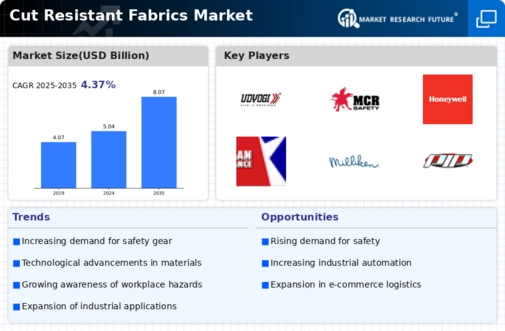Market Growth Projections
The Global Cut Resistant Fabrics Market Industry is poised for substantial growth, with projections indicating an increase from 5.04 USD Billion in 2024 to 8.07 USD Billion by 2035. This growth trajectory suggests a compound annual growth rate of 4.37% from 2025 to 2035. Such projections reflect the increasing adoption of cut-resistant fabrics across various industries, driven by safety regulations and technological advancements. The market's expansion is likely to be supported by continuous innovations in fabric technology and the diversification of applications, ensuring that cut-resistant materials remain integral to protective clothing.
Expansion of End-User Industries
The expansion of end-user industries, including automotive, healthcare, and food processing, propels the Global Cut Resistant Fabrics Market Industry. As these sectors increasingly adopt cut-resistant materials for protective gear, the demand for such fabrics is expected to rise. For instance, the automotive industry utilizes cut-resistant fabrics in manufacturing components that require high durability. This trend indicates a broader acceptance of cut-resistant solutions across various applications, contributing to the market's projected growth to 8.07 USD Billion by 2035. The diversification of applications underscores the versatility and necessity of cut-resistant fabrics in modern manufacturing.
Growing Demand for Workplace Safety
The increasing emphasis on workplace safety across various industries drives the Global Cut Resistant Fabrics Market Industry. As organizations prioritize employee protection, the demand for cut-resistant clothing and gear rises. For instance, industries such as construction and manufacturing have adopted stringent safety regulations, leading to a surge in the use of cut-resistant fabrics. This heightened focus on safety is projected to contribute to the market's growth, with an estimated value of 5.04 USD Billion in 2024. Companies are increasingly investing in advanced materials to enhance protection, thereby expanding the market's scope.
Regulatory Compliance and Standards
Regulatory compliance and safety standards play a crucial role in shaping the Global Cut Resistant Fabrics Market Industry. Governments worldwide are implementing stringent regulations to ensure the safety of workers in hazardous environments. Compliance with these regulations necessitates the use of cut-resistant materials in protective clothing. For instance, the introduction of ISO standards for protective clothing has led to increased demand for certified cut-resistant fabrics. This regulatory landscape not only drives market growth but also encourages manufacturers to innovate and improve their product offerings, ensuring that they meet the evolving safety requirements.
Technological Advancements in Fabric Production
Innovations in fabric technology significantly influence the Global Cut Resistant Fabrics Market Industry. The development of high-performance fibers, such as aramid and polyethylene, enhances the cut resistance of fabrics. These advancements enable manufacturers to produce lighter, more comfortable, and more effective protective clothing. For example, the introduction of composite yarns has improved the durability and flexibility of cut-resistant fabrics. As a result, the market is likely to witness a compound annual growth rate of 4.37% from 2025 to 2035, reflecting the industry's adaptability to evolving safety standards and consumer preferences.
Rising Awareness of Personal Protective Equipment
The rising awareness of personal protective equipment (PPE) among consumers significantly impacts the Global Cut Resistant Fabrics Market Industry. As individuals become more conscious of safety in various environments, the demand for cut-resistant apparel and gear increases. This trend is particularly evident in sectors such as food service and healthcare, where the risk of cuts and injuries is prevalent. Educational campaigns and training programs further promote the importance of using cut-resistant materials, thereby enhancing market growth. The collective awareness surrounding PPE is likely to sustain the upward trajectory of the market in the coming years.




















Leave a Comment